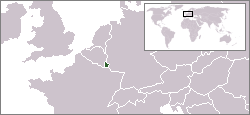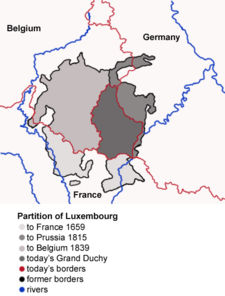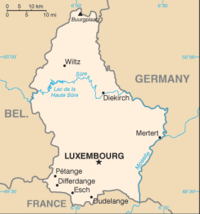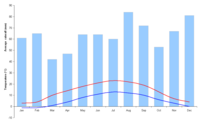Luxembourg
2007 Schools Wikipedia Selection. Related subjects: Countries; European Countries
| Grand-Duché de Luxembourg Großherzogtum Luxemburg Groussherzogtum Lëtzebuerg Grand Duchy of Luxembourg |
|||||
|
|||||
| Motto: Luxembourgish: Mir wëlle bleiwe wat mir sinn (English: "We wish to remain what we are") |
|||||
| Anthem: Ons Hémécht ("Our Homeland") Royal anthem: De Wilhelmus 1 |
|||||
| Capital | Luxembourg |
||||
|---|---|---|---|---|---|
| Largest city | Luxembourg | ||||
| Official languages | French, German, Luxembourgish ( de jure since 1984) |
||||
| Government | Grand duchy | ||||
| - Grand Duke | Grand Duke Henri ( List) | ||||
| - Prime minister | Jean-Claude Juncker ( List) | ||||
| Independence | |||||
| - Declared | 1815 | ||||
| - Confirmed | 1839, 1867 | ||||
| Accession to EU | March 25, 1957 | ||||
| Area | |||||
| - Total | 2,586 km² ( 176th) 999 sq mi |
||||
| - Water (%) | negligible | ||||
| Population | |||||
| - 2005 estimate | 465,000 ( 168th) | ||||
| - 2001 census | 439,539 | ||||
| - Density | 171/km² ( 59th) 469/sq mi |
||||
| GDP ( PPP) | 2005 estimate | ||||
| - Total | $29.37 billion ( 92nd) | ||||
| - Per capita | $69,800 (2005) ( 1st) | ||||
| GDP (nominal) | 2005 estimate | ||||
| - Total | $34.18 billion ( 64th) | ||||
| - Per capita | $80,288 ( 1st) | ||||
| HDI (2004) | 0.945 (high) ( 12th) | ||||
| Currency | Euro ( €)2 ( EUR) |
||||
| Time zone | CET ( UTC+1) | ||||
| - Summer ( DST) | CEST ( UTC+2) | ||||
| Internet TLD | .lu3 | ||||
| Calling code | +352 | ||||
| 1 This is not the same as Het Wilhelmus of the Netherlands. 2 Prior to 1999: Luxembourgish franc. 3 The .eu domain is also used, as it is shared with other European Union member states. |
|||||
The Grand Duchy of Luxembourg ( Luxembourgish: Groussherzogtum Lëtzebuerg, French: Grand-Duché de Luxembourg, German: Großherzogtum Luxemburg) is a small landlocked country in western Europe, bordered by Belgium, France, and Germany. Luxembourg has a population of under half a million people in an area of about 2,600 square kilometres (1,000 sq mi).
Luxembourg is a parliamentary representative democracy with a constitutional monarchy, ruled by a Grand Duke. It is the world's only sovereign Grand Duchy. Luxembourg is a founding member of the European Union, NATO, the United Nations, Benelux, and the Western European Union, reflecting the political consensus in favour of economic, political, and military integration. Luxembourg City, the capital and largest city, is the seat of several institutions and agencies of the European Union.
Luxembourg lies on the cultural divide between Romance Europe and Germanic Europe, borrowing customs from each of the distinct traditions. While French and Luxembourgish are the predominant languages in daily life and on the streets, Luxembourg remains a trilingual country; French, German, and Luxembourgish are official languages. Although a secular state, Luxembourg is a predominantly Roman Catholic country.
History
The recorded history of Luxembourg begins with the construction of Luxembourg Castle in 963. Around this fort, a town gradually developed, which became the centre of a small, but important, state of great strategic value. In 1437, the House of Luxembourg suffered a succession crisis, precipitated by the lack of a male heir to assume the throne. In the following centuries, Luxembourg's fortress was steadily enlarged and strengthened over the years by its successive occupants, the Bourbons, Habsburgs, Hohenzollerns, and the French, among others. After the defeat of Napoleon in 1815, Luxembourg was disputed between Prussia and the Netherlands. The Congress of Vienna formed Luxembourg as a Grand Duchy in personal union with the Netherlands. Luxembourg also became a member of the German Confederation, with a Confederate fortress manned by Prussian troops.
The Belgian revolution of 1830– 1839 reduced Luxembourg's territory by more than half, as the predominantly francophone western part of the country was transferred to Belgium. Luxembourg's independence was reaffirmed by the 1839 First Treaty of London. In the same year, Luxembourg joined the Zollverein. Luxembourg's independence and neutrality were again affirmed by the 1867 Second Treaty of London, after the Luxembourg Crisis nearly led to war between Prussia and France. After the latter conflict, the Confederate fortress was dismantled.
The King of the Netherlands remained Head of State as Grand Duke of Luxembourg, maintaining personal union between the two countries until 1890. At the death of William III, the Dutch throne passed to his daughter Wilhelmina, while Luxembourg (at that time restricted to male heirs; see Salic Law) passed to Adolph of Nassau-Weilburg.
Luxembourg was invaded and occupied by Germany during the First World War, but was allowed to maintain its independence and political mechanisms. It was again subject to German occupation in the Second World War, and was formally annexed into the Third Reich in 1942.
During World War II, Luxembourg abandoned its policy of neutrality, when it joined the Allies in fighting Germany. Its government, exiled to London set up a small group of volunteers, who participated in the Normandy invasion. It became a founding member of the United Nations in 1946, and of NATO in 1949. In 1957, Luxembourg became one of the six founding countries of the European Economic Community (later the European Union), and, in 1999, it joined the euro currency area. In 2005, a referendum on the EU treaty establishing a constitution for Europe was held in Luxembourg.
Government and politics
Luxembourg has a parliamentary form of government with a constitutional monarchy inherited by male-preference primogeniture. Under the constitution of 1868, executive power is exercised by the Grand Duke or Grand Duchess and the cabinet, which consists of a Prime Minister and several other ministers. The Grand Duke has the power to dissolve the legislature and reinstate a new one. However, since 1919, sovereignty has resided with the country.
Legislative power is vested in the Chamber of Deputies, a unicameral legislature of 60 members, who are directly elected to 5-year terms from four constituencies. A second body, the Council of State (Conseil d'État), composed of 21 ordinary citizens appointed by the Grand Duke, advises the Chamber of Deputies in the drafting of legislation.
The Grand Duchy has three lower tribunals (justices de paix; in Esch-sur-Alzette, Luxembourg City, and Diekirch), two district tribunals (Luxembourg City and Diekirch) and a Superior Court of Justice (Luxembourg City), which includes the Court of Appeal and the Court of Cassation. There is also an Administrative Tribunal and an Administrative Court, as well as a Constitutional Court, all of which are located in Luxembourg City.
Luxembourg's contribution to its defence and to NATO consists of a small army. As a landlocked country, it has no navy, and it has no air force, except for the fact that the 18 NATO AWACS airplanes were registered as aircraft of Luxembourg as a matter of political and aviational convenience. In a joint agreement with Belgium, both countries have put forth funding for one A400M military cargo plane, and have it on order. Luxembourg still maintains three Boeing 707 model TCAs for cargo and training purposes based in NATO Air Base Geilenkirchen.
Geography and climate
Luxembourg is one of the smallest countries in Europe, and ranked 175th in size of all the countries of the world; the country is about 2,586 square kilometres (999 sq. mi) in size, and measures 82 km (51 miles) long and 57 km (35 miles) wide. To the east, Luxembourg borders the German Bundesländer of Rhineland-Palatinate and Saarland, and, to the south, it borders the French région of Lorraine. The Grand Duchy borders the Belgian Walloon Region, in particular the latter's provinces of Luxembourg and Liège to the west and to the north respectively.
The northern third of the country is known as the ' Oesling', and forms part of the Ardennes. It is dominated by hills and low mountains, including the Kneiff, which is the highest point, at 560 metres (1,837 ft). The region is sparsely populated, with only one town ( Wiltz) with a population of more than 2,000 people.
The southern two-thirds of the country is called the ' Gutland', and is more densely populated than the Oesling. It is also more diverse, and can be divided into five geographic sub-regions. The Luxembourg plateau, in south-central Luxembourg, is a large, flat, sandstone formation, and the site of Luxembourg City. Little Switzerland, in the east of Luxembourg, has craggy terrain and thick forests. The Moselle valley is the lowest-lying region, running along the south-eastern border. The Red Lands, in the far south and southwest, are Luxembourg's industrial heartland and home to many of Luxembourg's largest towns.
The border between Luxembourg and Germany is formed by three rivers: the Moselle, the Sauer, and the Our. Other major rivers are the Alzette, the Attert, the Clerve, and the Wiltz. The valleys of the mid-Sauer and Attert form the border between the Gutland and the Oesling.
Luxembourg is divided into 3 districts, which are further divided into 12 cantons, and then into 116 communes.
Twelve of the communes have city status, of which Luxembourg City is the largest.
Luxembourg has a mild continental climate, marked by high precipitation, particularly in late summer.
Demographics
As of 2000, there were 162,000 immigrants in Luxembourg, accounting for 37 percent of the total population. The native population is ethnically a French and Germanic blend. The indigenous population was augmented by immigrants from Belgium, France, Germany, Italy, and Portugal throughout the twentieth century. Since the beginning of the Yugoslav wars, Luxembourg has seen many immigrants from war-torn and politically unstable Balkan states, such as Bosnia and Herzegovina, Montenegro, and Serbia. Annually, over 10,000 new immigrants arrive in Luxembourg, mostly from EU states, as well as Eastern Europe. There are an estimated 5,000 illegal immigrants in Luxembourg.
Language
The linguistic situation in Luxembourg is characterised by the practice and the recognition of three official languages: French, German, and Luxembourgish, a Franconian language of the Moselle region similar to German. Apart from being one of the three official languages, Luxembourgish is also considered the national language of the Grand Duchy.
None of the three languages predominates generally, and each is used as the primary language in certain spheres. Luxembourgish is generally preferred for spoken use, but is superseded by both French and German for written purposes. French is the language in which most government business is carried out. German is the language of most media and of the church.
In addition to the three native languages, English is taught from a young age (mostly 2nd grade, i.e. at the age of 13 to 14 years), and most of the population of Luxembourg is proficient in English. Portuguese and Italian, the languages of the two largest immigrant communities, are also spoken by large parts of the population, but by relatively few from outside their respective communities.
Religion
Since 1979, it has been illegal to collect statistics on religious beliefs or practices. It is estimated that 87 percent of Luxembourgers are Roman Catholics, and the other 13 percent are mostly Protestants, Orthodox Christians, Jews, and Muslims. Luxembourg is a secular state, but the state recognises certain religions as officially-mandated religions. This gives the state a hand in religious administration and appointment of clergy, in exchange for which the state pays certain running costs and wages. Currently, religions covered by such arrangements are Roman Catholicism, Judaism, Greek and Russian Orthodoxy, and Protestantism.
Economy
Luxembourg's stable, high-income economy features moderate growth, low inflation, and low unemployment. The industrial sector, which was until recently dominated by steel, has become increasingly more diversified to include chemicals, rubber, and other products. During the past decades, growth in the financial sector has more than compensated for the decline in steel. Services, especially banking and other financial exports, account for the majority of economic output. Agriculture is based on small, family-owned farms. Luxembourg has especially close trade and financial ties to Belgium and the Netherlands (see Benelux), and as a member of the EU, enjoys the advantages of the open European market. Luxembourg possesses the highest GDP per capita in the world ( US$72,945 as of 2005), the fourth-highest HDI, and the fourth-highest quality of life. Unemployment is 4.8% of the labour force as of March 2006. For the fiscal year of 2005 and current year 2006, Luxembourg has run a budget deficit for the first time in many years mostly because of slower growth and the slowdown of the international markets.
Neighboring Countries
 |
 |
|||






